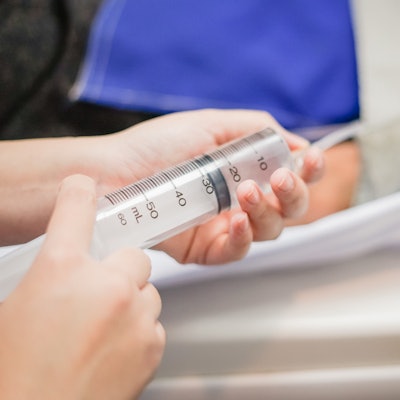
The current shortage in the U.S. of iodinated CT contrast is prompting radiology departments to make dramatic changes in imaging protocols and patient triage from the short- to long-term, according to a special report published May 19 in Radiology.
A group led by Dr. Thomas Grist of the University of Wisconsin in Madison offered a range of strategies for coping with the situation and urged radiology departments to assess how they procure CT contrast.
"We must embrace this situation as a call to action to identify and correct other potential weaknesses in our supply chain that might limit our ability to care for the patients we serve," Grist told AuntMinnie.com.
In May, the Greater New York Hospital Association (GNYHA) warned its member hospitals about a shortage of GE Healthcare's Omnipaque iodinated contrast media, caused by a COVID-19 lockdown in Shanghai, China, where GE's main manufacturing facility is located. The supply chain disruption is having negative effects on patient care, but it's possible that coping with COVID-19 has prepared radiology to better handle the situation, Grist said.
"We are all better positioned to handle supply chain issues like this after our experience during the early days of the pandemic, including implementing incident response command centers with tiered strategies for responding to the shortage depending on each center's supply," he said. "I am optimistic that our innovative radiology community will continue to adapt and ultimately prevail for this particular shortage."
As of the publication of the report, one-third of GE's Shanghai workforce is quarantined in the compound, according to Grist's group. GE's other facility capable of producing Omnipaque, in Cork, Ireland, is operating at maximum capacity. The company "expects the shortage to be most severe over the next two weeks, with persistent supply issues through the end of June 2022," the authors wrote. But things may be improving, Grist told AuntMinnie.com.
"As I understand, the Shanghai production facility is now at 50% production, which is good news, and the manufacturer has shifted to delivery by air rather than by ship, so I am optimistic that the trajectory is in a good direction," he said.
Bayer, Bracco Diagnostics, GE, and Guerbet all supply iodinated contrast media to U.S. hospitals; the agents consist of iohexol and iopamidol, and these two agents split the market share. But Bayer, Bracco, and Guerbet aren't able to boost production to meet contrast demand in the face of GE's supply chain crunch, the authors explained.
The team outlined three strategies for dealing with the CT contrast shortage:
- Short-term (immediate) response: Create a command center to direct and monitor contrast use. Delay elective contrast-enhanced CT exams and use contrast dose reduction strategies and other imaging modalities. "Radiology departments and healthcare institutions need to immediately assess their daily utilization of iodinated contrast media, the total ICM supply available, predicted deliveries in the near future, and the estimate of days of ICM on-hand," the team urged.
- Midterm (next two months) response: Repackage contrast into smaller doses, convert single vials to multiuse, and stay in active communication with ordering providers about CT exams. "Repackaging may be considered for smaller ICM aliquots," the authors wrote. "If multi-use is considered, contrast transfer sets are used with tubing and one-way valves to prevent microbial introduction into the ICM ... [and] radiology departments involved in ICM shortage planning need to actively communicate the nature, extent, and new ICM policies to ordering providers."
- Long-term (next two years) response: Support legislation that would expand contrast manufacturing in the U.S. and the institutional storing of contrast. "Globalization of the supply chain and just-in-time delivery have been upended by the COVID-19 pandemic and the recent war in Ukraine," the team noted. "The challenges of the past few years have affected the longstanding plans of the world's largest companies and are forcing them to reconsider the basic tenets of the supply chain."
Radiology is facing a new reality now when it comes to contrast supply, according to the authors.
"We are painfully learning that the hospital supply chains are vulnerable to the vicissitudes of politics/country of origin and the pandemic," Grist's team noted. "Few might have imagined that China would quarantine the entire population of cities as large as the quarantines of Shanghai (26 million people) ... as a response to COVID-19."





















